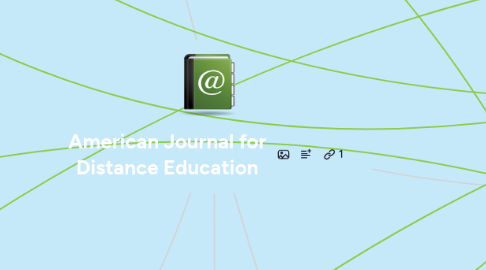
1. Online Course and Instructional Design
1.1. Digital Primary Sources
1.1.1. online collaboration
1.1.1.1. identify primary sources
1.1.1.2. cultural awareness
1.1.2. virtual collaboration
1.2. Frameworks
1.2.1. Culturally Appropriate Frameworks
1.2.1.1. Sensitivity to Cultural Challenges
1.2.2. Cross-Cultural Online Learning and Teaching
1.3. Massive Online Open Course (MOOC)
1.3.1. Student Achievement
1.3.1.1. Enhance Student Learning
1.3.1.2. Student Success
1.3.1.3. Motivation
1.3.2. Social Media
1.4. Assessments
1.4.1. Timed Online Tests
1.4.2. Test Results
1.5. E-textbooks
1.5.1. Cheaper
1.5.2. Convenient
1.6. Qualitative Inquiry (Online Contexts)
1.6.1. Responsive
1.6.1.1. developing community
1.6.2. Reflexive
1.6.2.1. examines assumptions
1.6.3. Recursive
1.6.3.1. multiple tools/strategies
1.6.4. Reflective
1.6.4.1. student-instructor
1.6.5. Contextual
1.6.5.1. context & delivery
2. Online Learning Interactions
2.1. Learner-Learner
2.1.1. Critical Discourse
2.1.2. Peer Collaboration
2.1.2.1. Synchronous Online Learning
2.1.2.1.1. higher education
2.1.2.1.2. k-12 schools
2.1.2.2. Social Media
2.1.2.2.1. Blogs
2.1.2.2.2. Cyber Bullying
2.1.2.2.3. Platforms
2.2. Learner-Content
2.2.1. Global Themes
2.2.2. Design Content to Meet Needs
2.3. Teacher-Teacher
2.3.1. Twitter
2.3.1.1. #EdChat
2.4. Learner-Instructor
2.4.1. Transactional Distance
2.4.1.1. Co-Understanding
2.4.1.2. Awareness
2.4.2. Feedback
2.4.2.1. Text
2.4.2.2. Screencasting
2.4.2.3. Voice
3. Online Learning Satisfaction
3.1. Cultural Perceptions
3.2. Student Perception
3.2.1. Increase self-efficacy
3.3. Faculty, Administrator, and Staff Perceptions
3.3.1. Increase Satisfaction
3.4. students' age and employment
3.4.1. older students
3.4.2. younger students
4. Factors Influencing Student Achievement in Online Learning
4.1. Peer Help
4.1.1. peer learning
4.1.1.1. effectiveness
4.1.1.1.1. Executive goals
4.1.1.1.2. Instrumental goals
4.1.2. Need for help
4.1.2.1. socially embarrassing
4.1.3. Online discussions
4.1.3.1. peer reviews
4.1.3.2. Critical thinking
4.2. Individual Competence
4.2.1. GPA
4.2.2. Knowledge Gains
4.2.3. Knowledge Retention
4.3. Student Engagement
4.3.1. Benefits
4.3.1.1. Provides interactivity
4.3.1.1.1. online/blended learning
4.3.1.2. Organization
4.3.1.2.1. Communication
4.3.2. Negatives
4.3.2.1. lack of face-to-face interaction
4.3.2.2. time management
4.3.2.2.1. unexpected events
4.3.2.3. job oportunities
4.4. Personal Attributes
4.4.1. Learning Styles
4.4.2. Gender
4.5. Social Media
4.5.1. Support Engagement
4.5.1.1. VR Math games
4.5.1.2. Blogs
4.5.2. Support Meaning Making:
5. Changing Roles of Faculty and Changes in Institutional Culture
5.1. Facilitator Support
5.1.1. Enhancing Cognitive Presence
5.2. Mentoring and Mentee Programs
5.3. Quality Matters
5.3.1. Evidence 1
5.3.2. Evidence 2
5.3.3. Evidence 3
5.3.4. Evidence 4

